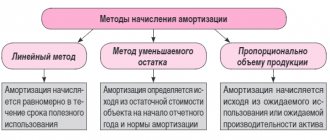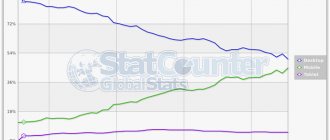Budgetary organizations are institutions financed from budgetary funds. Accounting in such organizations is carried out on the basis of a special chart of accounts for budgetary institutions with their own entries, which was approved by Order No. 174n of the Ministry of Finance of the Russian Federation dated December 16, 2010. In all budgetary institutions, fixed assets, according to Instruction No. 25n, are accounted for in account No. 010100000 - Basic facilities.
Let's consider accounting for fixed assets in budgetary institutions in 2020 and 2021 for beginners.
Signs that an object is classified as fixed assets in budgetary institutions:
- its use in the course of the organization’s activities for management needs, during the performance of work or provision of services;
- The useful life of such an object is over 12 months.
The minimum cost for fixed assets of budgetary organizations has not been established.
Rice. 1. Classification of fixed assets of budgetary organizations.
Group accounting of fixed assets in a budgetary institution can be carried out for objects costing up to 40,000 rubles.
Fixed assets of budgetary institutions also include:
- the tenant's completed capital investments in the properties leased by him;
- investment in perennial plantings.
Types of property of a budgetary institution
According to paragraph 9 of Art. 9.2 of the Law “On Non-Profit Organizations” dated January 12, 1996 No. 7-FZ, all property of the BU is under its operational management, and the owner is the state. The table below discusses how a BU can manage its OS objects.
| Types of property | Property disposal rules |
| Real estate | |
| Any real estate | It is necessary to obtain the consent of the owner for any transactions with this property |
| Movable property | |
| Particularly valuable property transferred and assigned by the owner to the BU | It is necessary to obtain the consent of the owner for any transactions with this property |
| Particularly valuable property purchased with funds received from the owner of the used property | |
| Particularly valuable property purchased with funds earned by the BU independently in carrying out operations that generate income | Manages independently. Exceptions:
|
| Other movable property | |
Particularly valuable property is movable property that ensures the activities of the BU and in the absence of which the statutory activities will be carried out with significant difficulties (Clause 11 of Article 9.2 of Law No. 7-FZ). The list of especially valuable movable property is fixed by the founding body.
How to write off materials from an off-balance sheet account?
Postings for capitalization and write-off from the account. 002 look like this:
| Debit | Credit | Contents of operation |
| 002 | Acceptance of inventory items for storage | |
| 002 | Disposal of inventory items accepted for storage |
Write-off of inventory items from the account. 002 is carried out on the basis of:
- form MX-3 or a similar document developed by the organization (taking into account the requirements of paragraph 2 of Article 9 of Law No. 402-FZ) to record the return of valuables accepted under a storage agreement;
- TORG-12, UPD or other documents - upon disposal of inventory items that were taken into account on the account. 002 within the framework of the supply agreement.
For operations with customer-supplied raw materials, the executing organization uses an off-balance sheet account. 003:
| Debit | Credit | Contents of operation |
| 003 | Received materials for processing | |
| 003 | Recycled materials were transferred to the customer |
If products are made from customer-supplied raw materials, then the entries in off-balance sheet accounting may be as follows:
| Debit | Credit | Contents of operation |
| 003 | Received materials for processing | |
| 003 | Customer-supplied raw materials are transferred to production | |
| 002 | Products made from customer-supplied materials have been capitalized | |
| 002 | Manufactured products were transferred to the customer |
With account 003 materials are written off based on:
- report on the consumption of customer-supplied raw materials (Article 713 of the Civil Code of the Russian Federation);
- work acceptance certificate;
- invoice M-15 or other similar documentation agreed upon by the parties.
When selling goods under a commission agreement, the commission agent is accounted for according to the account. 004 there will be the following accounting entries:
| Debit | Credit | Contents of operation |
| 004 | Goods received under a commission agreement were capitalized | |
| 004 | Products accepted for commission were sold |
Write-off of inventory items from an off-balance sheet account. 004 is carried out on the basis of the primary document drawn up upon the sale of valuables - TORG-12, invoice, UPD or other documentation agreed upon by the parties to the commission agreement.
Rules for writing off fixed assets in budgetary institutions in 2021 -2021
Decommissioning of the OS can occur for the following reasons:
- The OS has lost its properties completely or partially and cannot function properly,
- The OS is no longer in use due to its destruction or loss.
The following are not grounds for writing off the OS:
- 100% depreciation of the asset;
- expiration of useful life;
- transfer of the OS into operation.
After the expiration of the useful life of a fixed asset, it is subject to write-off only if it is truly unsuitable for further use and its restoration is impossible or economically impractical (for example, if the cost of restoration exceeds the benefits that can be obtained from the use of this object).
To write off fixed assets, an institution must organize a special commission that operates constantly to make decisions on such issues (clause 34 of the Unified Chart of Accounts, approved by order of the Ministry of Finance of the Russian Federation dated December 1, 2010 No. 157n). The commission must draw up and approve the write-off act:
- non-financial assets (except for vehicles) (form according to OKUD 0504104);
- vehicle (form according to OKUD 0504105);
- soft and household equipment (form according to OKUD 0504143);
- excluded objects of the library collection (form according to OKUD 0504144).
These forms were approved by order of the Ministry of Finance of Russia dated March 30, 2015 No. 52n. These forms began to be used by BU in 2015 and continue to be used in 2020-2021.
The act must be agreed upon with the founder of the BU, if required by law. Next, the head of the accounting department endorses the act, after which actions are taken to uninstall, disassemble, liquidate the OS, and only after that the write-off is reflected in accounting on the basis of the act (clause 52 of the Unified Chart of Accounts).
A sample of filling out an act on write-off of fixed assets according to form 0504105 is available in ConsultantPlus. Get free demo access to K+ and download the document.
The list of documents that must be prepared by the commission to approve the disposal of fixed assets depends on who is the founder of the BU, that is, the owner of its property. If the BU is created on the basis of the property of a constituent entity of the Russian Federation or a municipality, then it is necessary to be guided by the legislative acts adopted by the relevant constituent entity or municipality.
If the property of the BU is federal, then the rules are established by the federal executive body to which the institution is responsible. The general document for accounting institutions managing federal property is the provision “On the specifics of writing off federal property”, approved by Decree of the Russian Federation dated October 14, 2010 No. 834, as well as the Procedure for submitting documents for approval of the write-off of federal property, approved by order of the Ministry of Economic Development and the Ministry of Finance of the Russian Federation dated March 10, 2011 No. 96/30n.
Write-off of materials to an off-balance sheet account
An organization can take into account not only other people's material assets on its balance sheet, but also its own. An example would be low-value property, household supplies and inventory that are used for more than 1 year, costing less than the limit for accepting an object for accounting as fixed assets (the organization sets this limit independently in its accounting policy, but it cannot be more than 40,000 rubles in accordance with p. 5 PBU 6/01).
Such materials are written off as expenses at a time. But due to the long period of use, it is necessary to organize control over their safety. For this purpose, you can create a record sheet for household supplies and equipment in use, or you can keep off-balance sheet accounting. In the Chart of Accounts, approved. By order No. 94n, there is no special account for these purposes, so the organization can develop an off-balance sheet account independently and approve the chosen procedure for writing off low-value materials in the accounting policy.
If you use the 1C:Enterprise computer program for accounting, then in the chart of accounts of this program, special off-balance sheet accounts are provided for accounting for low-value materials written off the balance sheet:
If the company decides to take into account the low value off the balance sheet, then the postings will be as follows:
| Debit | Credit | Contents of operation |
| 20, 23, 25, 26, 29, 44 | 10 | Released from inventory warehouse |
| Off-balance sheet account “Inventory and household supplies” | Inventory and materials transferred into operation are registered | |
| Off-balance sheet account “Inventory and household supplies” | Inventory written off |
Such inventory items are written off from the off-balance sheet account:
- after they are completely worn out, an MB-8 act or another document is drawn up, developed taking into account the requirements for mandatory details (clause 2 of article 9 of law No. 402-FZ);
- sale, gratuitous transfer and other disposal.
Accounting for write-off of fixed assets
Accounting entries for the disposal of fixed assets are given in paragraph 10 of the section “Non-financial assets” of the Instructions for the use of the budget chart of accounts, approved. by order of the Ministry of Finance of the Russian Federation dated December 6, 2010 No. 162n. Here are the main entries:
| Description | Dt | CT |
| Write-off of assets due to loss, shortage, destruction for reasons not related to natural disasters | 010400000 “Depreciation” (010411410–010413410, 010415410, 010418410, 010421410–010428410, 010431410–010438410, 010441410–010448410), 0 40110172 “Income from operations with assets” | 010100000 “Fixed assets” (010111410–010113410, 010115410, 010118410, 010121410–010128410, 010131410–010138410, 010141410–010148410) |
| Write-off of fixed assets in connection with emergencies and natural disasters | 010400000 “Depreciation” (010411410–010413410, 010415410, 010421410–010428410, 010431410–010438410, 010441410–010448410), 040120273 “Through extraordinary expenses on transactions with assets" | 010100000 “Fixed assets” (010111410–010113410, 010115410, 010121410–010128410, 010131410–010138410, 010141410–010148410) |
| Write-off of the OS for other reasons, including in connection with the decision of the commission to end the use of the OS due to loss of technical properties | 010400000 “Depreciation”, 040110172 “Income from operations with assets” | 010100000 “Fixed assets” |
| Assets for which a decision has been made to write off, but dismantling measures have not yet been carried out, are reflected on the balance sheet | 02 “Material assets accepted for storage” | |
| Materials remaining after write-off of fixed assets have been accepted for accounting | 010500000 “Inventories” (010521340–010526340, 010531340–010536340) | 040110172 “Income from operations with assets” |
| The costs of carrying out work to write off the operating system are reflected | 040120200 “Expenses of an economic entity” | 030211730 “Increase in payables for wages”, 030306730–030311730 “Increase in payables for insurance premiums”, etc. |
A sample act on the liquidation of an asset was provided by ConsultantPlus experts. If you do not have access to the K+ system, get a trial online access for free.
For general information about fixed assets in budget accounting, read the article “Budget accounting of fixed assets in 2020-2021 (nuances)” .
Read about innovations in budget accounting in the article “Working chart of accounts of budget accounting for 2020 - 2021” .
Modernization of property assets on your own
The budgetary institution modernized the machine complex (1,000,000 rubles) by replacing unsuitable parts (120,000 rubles), installation of parts by a third party - 20,000 rubles.
| Contents of operation | Debit | Credit | Amount (rubles) |
| The costs of purchasing parts for the modernization behavior are taken into account | 4 106 X1 310 | 4 105 36 440 | 120 000 |
| The costs of installing parts are reflected | 4 106 X1 310 | 4 302 26 730 | 20 000 |
| The cost of the machine complex was increased through modernization | 4 101 XX 310 | 4 106 X1 310 | 140 000 (120 000 + 20 000) |
Results
The write-off of fixed assets should be carried out solely upon the consideration of a commission that meets and is appointed by order of the head of the institution.
Documents must be drawn up in accordance with the legal regulations of federal, municipal bodies or bodies of constituent entities of the Russian Federation. In accounting, write-off is carried out after the actual liquidation of the asset. You can find more complete information on the topic in ConsultantPlus. Free trial access to the system for 2 days.
Coordination with the subject of management
- on inventory accounting accounts - components, parts, materials and assemblies suitable for repair of other equipment or for further use, as well as materials received as a result of write-off of property;
- on the accounting accounts OS - OS;
- as secondary raw materials - unsuitable components, parts, materials and assemblies.
- refrigerator: initial cost – 7,500 UAH; depreciation as of 01/01/17 – 4,286 UAH; residual value 01/01/17 – 3,214 UAH. (7,500 UAH – 4,286 UAH). This amount as of 01/01/17 was transferred to subaccount 5111. Over 2 years of operation, depreciation was accrued in the amount of UAH 2,142. Depreciation as of 01/01/19 – 6,428 UAH. (4,286 UAH. 2,142 UAH). Residual value – 1,072 UAH. Due to the write-off of the refrigerator, usable spare parts worth 800 UAH were received. and scrap metal in the amount of 210 UAH;
- computer: initial cost – 6,750 UAH; depreciation as of 01/01/19 – 6,750 UAH; residual value – 0 UAH.
More on the topic Employee recall from vacation in 2021
- for depreciable property objects not used in business activities - based on their depreciable cost and annual (monthly) depreciation rates (amounts) for these objects calculated in accordance with the established standard service lives.
Features of off-balance sheet accounting
Off-balance sheet accounts are a special section of the Chart of Accounts (approved by Order of the Ministry of Finance dated October 31, 2000 No. 94n).
Off-balance sheet accounts were separated into a separate group of accounts due to their specifics: objects on them are reflected by a simple entry, that is, only by debit or credit of the account. In off-balance sheet property accounts, the accountant takes into account assets that are temporarily held by the organization and do not belong to it.
Some company obligations and documents accounted for in a special manner are also written off to off-balance sheet accounts - read the details in the article “Rules for maintaining accounting on off-balance sheet accounts.”






